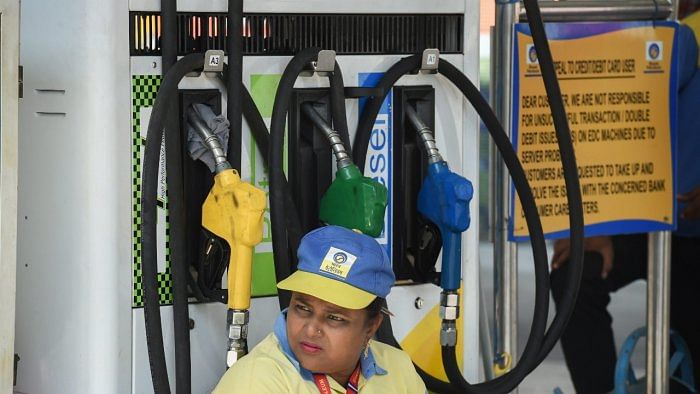
There was a roar of protest among states last week when Prime Minister Narendra Modi called out opposition-ruled states on fuel taxes. In what was clearly a political move, he asked them to adhere to the spirit of cooperative federalism and reduce taxes in line with the excise duty reduction by the Centre to bring down the prices of petrol and diesel. Seven states -- Maharashtra, West Bengal, Telangana, Andhra Pradesh, Tamil Nadu, Kerala and Jharkhand have not reduced the state taxes on the two transport fuels. The Centre had reduced excise duty on petrol and diesel in November last year by Rs 5 and Rs 10 a litre, respectively.
While the Centre says that pump prices of petrol and diesel can come down if states cut Value Added Tax (VAT) on them, the states argue that it’s the Centre’s cess and surcharge that has kept fuel prices high. Will the prices really come down significantly only if state governments cut VAT? No. While both the Centre and the states rely heavily on taxing fuel to fill their coffers, it’s the Centre that takes a major chunk of the revenue. It does share with the states 41% of the total tax revenue, which is mainly excise duty, but what the Modi government has done is to cleverly redesign its tax kitty in such a way that the overall tax pie that has to be shared with the states is itself reduced while it collects and keeps more revenue in the form of cess, which it does not need to share with the states.
That also explains why there is still no decision to bring petrol and diesel under the GST ambit. Neither the Centre nor the states are willing to forgo the revenue they collect from taxing fuels outside the GST regime. The tax rate, at present, on the two fuels by the Centre and states together accounts for more than half the pump prices of the fuels. The highest GST slab rate is 28%, applied on luxury and sin goods.
So, what kind of taxes does the Centre levy on petroleum products, what do the states levy, and how do these impact the common man in the form of inflation?
The Centre imposes excise duty on petrol and diesel, which has two components – tax, and cess and surcharge. The revenue generated from the tax component only falls under the Centre-state divisible pool, and not the cess and surcharge. But on the tax side, too, there are two sub-heads. Basic excise duty and special additional excise duty. Of these, again, the special additional excise duty is not a part of the divisible pool. It is through this special duty that the
Centre has been bolstering its revenues of late.
Between October 2019 and May 2020, the Centre hiked the special excise duty three times. So much so that the Union Budget of 2021 amended the Finance Bill and raised the limit up to which the government can raise special excise duty on petrol and diesel to Rs 18 per litre and Rs 12 per litre, respectively. The move allowed the Centre’s excise kitty to swell to Rs 3.84 lakh crore in 2020-21, compared to a little above Rs 1 lakh crore in 2014-15 when the Modi government assumed power at the Centre.
Thus, most of the excise duty collected remains with the Centre despite being part of the tax component and therefore in the divisible pool – simply because it is collected under the head ‘Special Additional Excise Duty’, which is currently almost Rs 11 per litre. The divisible pool of excise duty, which is known as basic excise duty is only Rs 1.40 per litre on petrol and Rs 1.80 per litre on diesel. This tiny sum is divided between the states. That is the main reason why the tax devolution to states has been falling, particularly after 2020.
The excise duty on petrol was Rs 22.98 per litre on March 14, 2020. It had risen to Rs 32.90 per litre on February 2, 2021. Similarly, the excise duty on diesel was Rs 18.83 per litre on March 14, 2020. It was 31.80 per litre on February 2, 2021, a hike of 68.8%.
Besides, the cess and surcharge imposed by the Centre on petrol includes a road and infrastructure development cess of Rs 18, and an agriculture infrastructure cess of Rs 2.50 per litre. Nothing from these goes to the states.
Now, what are the state taxes on transport fuels? The states can levy only a VAT. VAT is levied on ad valorem basis, that is to say, the states’ tax revenue from petrol and diesel rises in tandem with the rise in their prices, unlike the fixed excise duty of the Centre. Of course, this gives them a lot of revenue, but the states contend that they need it since the devolution of funds from the Centre is shrinking. The BJP-ruled states, which have reduced VAT, too, are complaining of loss of revenues.
So, if rising inflation is a concern, it is the Centre that needs to cut levies for a sizable impact. Petrol and diesel have a combined weight of 4.69% in the WPI index and 2.34% in the CPI index. Any increase in the prices of auto fuels has a pass-through effect on other commodities.
The record high prices for diesel means that the cost of transporting goods has gone up all over the country, which in turn puts pressure on the prices of essential commodities like fruits and vegetables. Increase in the CPI is often factored in by the RBI which, in an unscheduled surprise policy decision, on Wednesday warned of high inflation in the coming months and increased interest rates to counter that.
